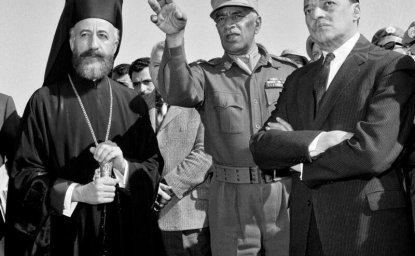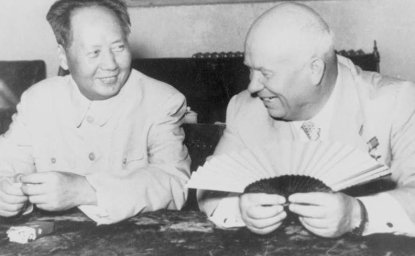By Balazs Szalontai
[Adapted from Balazs Szalontai, „Tsedenbal's Mongolia and the Communist Aid Donors: A Reappraisal," IIAS Newsletter 35 (November 2004) Leiden: International Institute for Asian Studies, www.iias.nl]
During the Cold War most Western observers saw the Mongolian Communist dictatorship headed by Yumjaagiin Tsedenbal as a puppet regime, unable and unwilling to defend the nation's interests against the Soviet Union. Following the democratic transition of 1989, this narrative became widely accepted in Mongolia as well. Recently studied Hungarian archival documents show, however, that the Mongolian Communist leadership resented foreign domination and made great efforts to pursue an independent economic policy.
The Mongolian People's Republic (MPR) was indeed more loyal to Moscow than was North Korea or North Vietnam, and Tsedenbal considered China rather than the USSR the greater threat to his rule and to Mongolian sovereignty. Nevertheless, diplomatic reports from the Hungarian Embassy in Ulaanbaatar reveal that Soviet-Mongolian relations were not as harmonious as the articles of Ünen, the Mongolian party newspaper, suggested.
Diplomats affronted
In September 1960 Communist diplomats accredited to the Mongolian People's Republic joined forces to lodge a formal complaint against their ill-treatment at the hands of various Mongolian cadres. The Soviets, though generally satisfied with the situation, found the clerks manning the special stores for diplomats very uncooperative. The Hungarians pointed out that the leaders of the mass organizations consistently ignored their requests for meetings. The Czechoslovak embassy was so laxly guarded that an unknown local managed to enter the ambassador's bedroom to ask for directions. The Poles noted that officials of the telephone exchange deliberately hindered them in contacting Warsaw. Even an otherwise reserved North Vietnamese diplomat complained bitterly about the recurrent shortages of electricity and water.
The diplomats' unfamiliarity with local customs and their patronizing attitude toward ‘backward' and ‘lazy' Mongols played a role in their complaints. However, these incidents did not result merely from cultural differences between Mongolians and the ‘fraternal' diplomats, but had much in common with the tactics that James C. Scott described in Weapons of the Weak: Everyday Forms of Peasant Resistance (New Haven: Yale University Press, 1985). That is, they constituted a form of subtle insubordination aimed at getting some psychological satisfaction without running the risk of a harsh reprisal.
If this interpretation is correct, the Mongolian officials achieved their aim, for the Hungarian diplomats, deceived by the pro-Soviet public statements the Mongolian leaders eagerly made, never suspected that the nuisances they suffered reflected hostility on the part of the top leadership. They instead blamed the incidents on incompetent low-level officials, or simply found them incomprehensible. Mongolian tactics, however, were strikingly similar to those that the Albanian and North Korean dictatorships, who were famous for their dislike for Khrushchev's policies, used against the Soviet and East European embassies in 1953-1964. In other words, they indicated tension between Mongolia and other Communist countries, a tension that is worth analyzing.
Weapons of the Weak
The forms such harassment took reveal some of the Mongols' motives. For instance, between 1960 and 1964 the Mongolian Foreign Ministry attempted to open diplomatic mail, monitor the activity of the diplomats, subject them to restrictive regulations, and prevent embassies from employing locals not hand-picked by the ministry. Spying on the fraternal diplomats seems to have started late in 1960, when the Hungarian Embassy described it as "a completely new phenomenon."1 In 1963 the Foreign Ministry instructed diplomats not to hunt without a shooting license, even though Mongolian citizens were free to purchase guns without a license. These measures reflected the Mongol wish to demonstrate their sovereignty, at least symbolically.
The emphasis the Mongolian People's Revolutionary Party (MPRP) laid on Mongolian sovereignty was accompanied by efforts to protect the dignity of its leadership, and, by implication, of the nation. Aware that their economically underdeveloped and politically dependent country was looked down upon by leaders and diplomats of other Communist regimes, the Mongolian leaders were touchy. As a Hungarian attaché warned a Vietnamese colleague in 1959, "since the Mongolian comrades are extremely proud and they easily take offence at trivial matters, one has to treat them with utmost care and caution."2
On other occasions Mongolian institutions demanded disproportionately large sums for their services, which was a way for the regime to extract greater resources from the ‘fraternal' countries whose economic assistance they considered insufficient.
Mongolia's Great Leap Forward
Anxious not to lag behind the more developed Communist countries, the MPRP leaders wanted the USSR, China and the East European countries to support the rapid industrialization of the MPR. Their plans were often quite grandiose and unrealistic. For instance, in 1959 Politburo member Luvsantserengiin Tsend informed the Hungarian Ambassador of a plan to replace the felt inside the yurts (gers) with plastic to be produced in Mongolia. In 1960 Deputy Premier Damdinjavyn Maidar asked the Hungarians to construct eight- to ten-story buildings in Ulaanbaatar. In 1961 Tsend only half-jokingly told the East German ambassador that the MPR wanted to catch up with the GDR by the mid-1960s. In 1961 the vice-chairman of the Mongolian State Planning Office flatly declared that the government considered the construction of a blast furnace in Darhan a political, rather than an economic, issue.
If donors pointed out that planned projects, like a sugar-refining factory, were incompatible with local economic and climatic conditions, the MPRP leaders did not hesitate to accuse them of being unwilling to assist Mongolia. When in 1960 the Hungarian ambassador told Politburo member Tsagaan-Lamyn Dugersuren that neon lights would not survive the Mongolian winter, Dugersuren replied: ‘Look, Comrade Ambassador, we are interested in the neon lights, not in why they cannot be installed. If the city council of Budapest really wants to help us, then they should rack their brains to make neon lights capable of withstanding even 50-60 degrees of frost. This would be a really fine gift.'3
Soviet Dissatisfaction with MPRP Policies
The Soviet leaders criticized the regime's disastrous rural policies, such as the low prices paid to producers and the insufficient emphasis on the production of hay, pointing out that these blunders resulted in high livestock losses. These criticisms were justified, as the MPRP leaders were unwilling to invest in the rural sector at the expense of industrialization.
Still, the Mongolian leadership must have understood that Soviet criticism was at least partly motivated by self-interest. The USSR wanted the MPR to concentrate on the export of meat and minerals, which would have perpetuated the country's over-specialization. In September 1960 the Soviets demanded a drastic revision of Mongolia's Third Five-Year Plan, and in the summer of 1962 Khrushchev flatly rejected Tsedenbal's request for additional aid. On the latter occasion the Soviet leader, known for his peculiar diplomatic style, gave his wristwatch to Tsedenbal, telling him that this was all he could give to Mongolia.
These Soviet steps aggravated the tension between the Mongolian authorities and the Communist diplomats. In the post-1963 period the intensification of the Sino-Soviet conflict helped to improve Soviet-Mongolian relations but also limited Ulaanbaatar's freedom of manoeuvre. The MPRP leaders tried to replace the constraints of Soviet-Mongolian bilateralism by participation in larger, multilateral economic and military structures. This motivation may have played a greater role in their expressed willingness to join COMECON [Council of Mutual Economic Assistance] and the Warsaw Pact than their loyalty to Moscow. In 1964 Maidar bluntly told a visiting COMECON delegation that the machines Mongolia had received from the USSR were often outdated, an evaluation confirmed by the East European delegates.
Conclusion
Nationalism spurred the MPRP leadership's economic policies in the period 1959-1964, which resulted in repeated clashes with the Kremlin. The Mongolian leaders did not merely represent the country's economic interests as best as they could but preferred the creation of a full-fledged, partly autarkic economic structure over economic cooperation on the basis of mutuality.
Several MPRP leaders whose rude or demanding behavior the Hungarian diplomats criticized, among them Maidar and Dugersuren, survived every purge of the 1959-1964 period and remained members of Tsedenbal's inner circle. This seems to confirm that their actions enjoyed at least the tacit support of Tsedenbal. While Tsedenbal usually refrained from direct involvement in such clashes, on some occasions he did take a stand. In 1960 he openly told the Hungarian ambassador that Soviet and Chinese aid was insufficient and the East European states had to increase their economic assistance.
While in the 1960s many Mongolian intellectuals felt that rapid modernization destroyed national traditions, the dictator and his supporters considered Mongolia's cultural heritage an essentially retarding influence. Unlike Daramyn Tömör-Ochir, one of Tsedenbal's most vocal critics, Tsedenbal and his inner circle did not play upon cultural nationalism. Nor did he express an interest in pan-Mongolism or attempt to break free from the USSR as drastically as did Kim Il Sung.
Still, the steps Tsedenbal and his supporters made in the field of economic and foreign policy call into question the depictions of the MPRP regime as simply a puppet of a foreign power. While Tsedenbal's views lacked commitment to ethnic nationalism, in certain respects they could be described as civic, state-centred nationalism.
Balázs Szalontai received a PhD in history from Central European University, Budapest, Hungary, in 2004, with a dissertation titled "Khrushchev versus Kim Il Sung, Soviet-DPRK Relations and the Roots of North Korean Despotism, 1953-1964," based largely on research in Hungarian archives. He is the author of "'You Have No Political Line of Your Own': Kim Il Sung and the Soviets, 1953-64," Cold War International History Project Bulletin, Issue 14/15 (Winter 2003-Spring 2004): 87-137. His interests cover the modern history of Korea, Vietnam, Mongolia, China and Albania. He is currently a research fellow at the National Institute for International Education Development in Seoul. He can be reached at aoverl@yahoo.co.uk.
Notes
1. Hungarian National Archives (MOL) XIX-J-1-j Mongolia 1945-1964, 5. doboz, 5/f, 008403/1960. Report, Hungarian Embassy in the MPR to the Hungarian Foreign Ministry, 14 December 1960.
2. MOL, XIX-J-1-j Mongolia 1945-64, 4. doboz, 5/f, 005082/1959. Memorandum, Hungarian Embassy in the MPR to the Hungarian Foreign Ministry, 17 July 1959.
3. MOL, XIX-J-1-j Mongolia 1945-1964, 5. doboz, 5/i, 006215/1960. Report, Hungarian Embassy in the MPR to the Hungarian Foreign Ministry, 29 August 1960.

Cold War International History Project
The Cold War International History Project supports the full and prompt release of historical materials by governments on all sides of the Cold War. Read more




